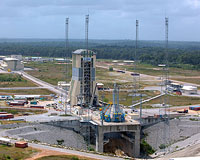 |
Kourou, French Guiana (SPX) May 09, 2011 The official ceremony marking ESA's handover of the Soyuz launch site to Arianespace took place at Europe's Spaceport in French Guiana, after the site was declared ready for the first flight and the completion of a simulated launch campaign. The French space agency, CNES, as prime contractor for the building work, along with its European and Russian partners, has spent recent months qualifying the site. In March, the 'acceptance review' declared that it was ready for its first rocket and at the same time CNES handed over the facilities to ESA. The last step was ESA's hand-over to Arianespace on 31 March. Arianespace became responsible for the Soyuz launch site and began a simulated launch campaign on 29 April that ended on 5 May. This dry run ensured that the Soyuz and the new facilities work together perfectly, while allowing the teams to train under realistic launch conditions. It validated all the procedures during the five-day final phase before a launch. The ceremony opened with speeches by Jean-Jacques Dordain, ESA Director General, Jean-Yves Le Gall, Chairman and CEO of Arianespace, Yannick d'Escatha, President of CNES, and Vladimir Popovkin, Head of Roscosmos. They were followed by Mr Dordain handing over the site's 'keys' to Mr Le Gall. To mark this occasion and to celebrate the recent 50th anniversary of the first man in space, a commemorative plaque and a stone from the Baikonur launch pad from which Yuri Gagarin took off in 1961 was sealed on the site. This stone symbolises the continuity between the Russian launch site, which saw the start of the space age with Sputnik followed by the first human spaceflight, and the setting up of a Soyuz launch operation in French Guiana. Soyuz at CSG 'Soyuz at CSG' - drawing on the French name of Centre Spatial Guyanais - is an ESA programme with the participation of seven Member States. The decision to develop the infrastructure to enable Soyuz to be launched from French Guiana was of mutual interest to both Europe and Russia. From a European perspective, closer cooperation with Russia brings significant benefits, such as a reduction in the development and production costs of new launcher systems, as well as opening the door to other possible commercial partnerships in the future. Construction of the Soyuz site began in February 2007, although initial excavation and ground infrastructure work began in 2005 and 2006, respectively. Russian staff arrived in French Guiana in mid-2008 to assemble the launch table, mobile gantry, fuelling systems and test benches. The first two Soyuz launchers arrived from Russia by sea in November 2009 to be assembled in the new preparation and integration building. The launch site is almost identical to the other Soyuz sites in Kazakhstan and Russia, although adapted to conform to European safety regulations. The most visible difference is the 45 m-tall mobile gantry, which allows payloads to be installed on the launcher vertically on the launch pad. Its internal movable work platforms provide access to the Soyuz at various levels for checkout activities. Soyuz fits neatly between the Ariane 5 and Vega launchers developed by ESA. Ariane 5 meets the requirements for larger satellites and Vega will complement this for smaller payloads. Soyuz also introduces the exciting potential for upgrading the new launch facility to allow manned launches to the International Space Station from French Guiana.
Share This Article With Planet Earth
Related Links Soyuz at Kourou Space Tourism, Space Transport and Space Exploration News
 Soyuz given "go" for simulated first launch
Soyuz given "go" for simulated first launchKourou, French Guiana (SPX) May 04, 2011 The "dry run" simulation of Soyuz' first flight from French Guiana was given the green light for a virtual liftoff this week with the successful conclusion of the launch readiness review, which was held in Arianespace's operations facility at the Spaceport. Following procedures similar to those used prior to every Ariane flight, the review validated the Soyuz launcher's "go" status, along ... read more |
|
| The content herein, unless otherwise known to be public domain, are Copyright 1995-2010 - SpaceDaily. AFP and UPI Wire Stories are copyright Agence France-Presse and United Press International. ESA Portal Reports are copyright European Space Agency. All NASA sourced material is public domain. Additional copyrights may apply in whole or part to other bona fide parties. Advertising does not imply endorsement,agreement or approval of any opinions, statements or information provided by SpaceDaily on any Web page published or hosted by SpaceDaily. Privacy Statement |